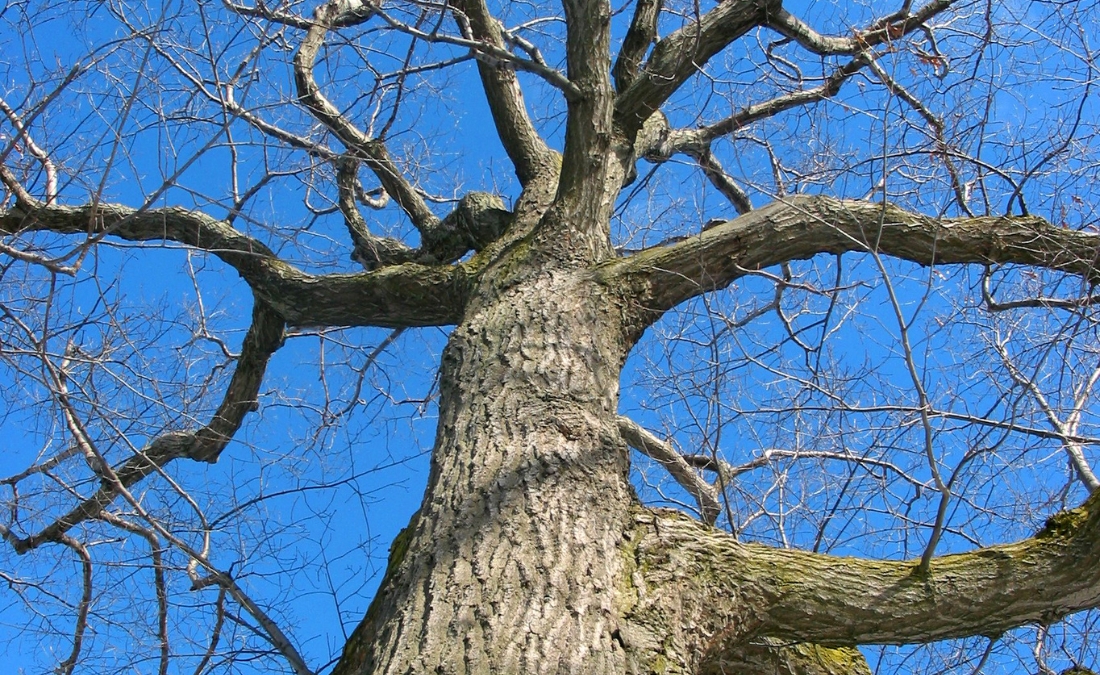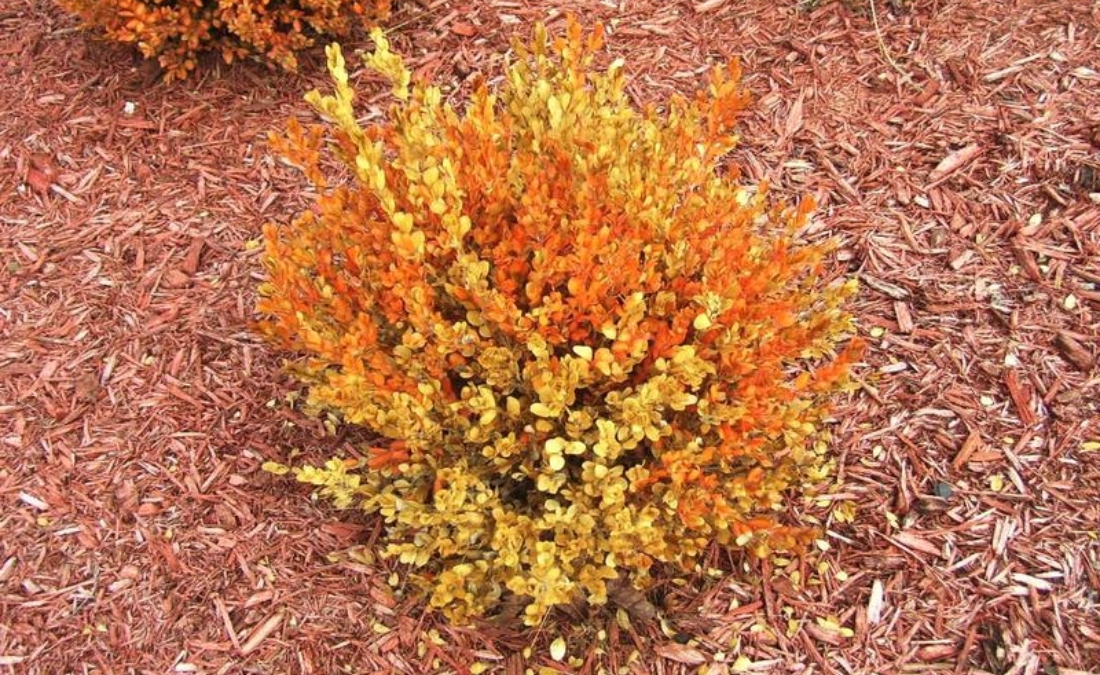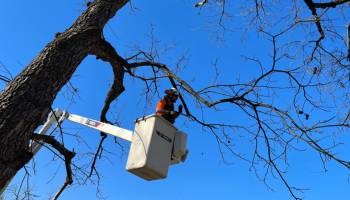Benefits of Fall Mulching for Central Midwest Trees
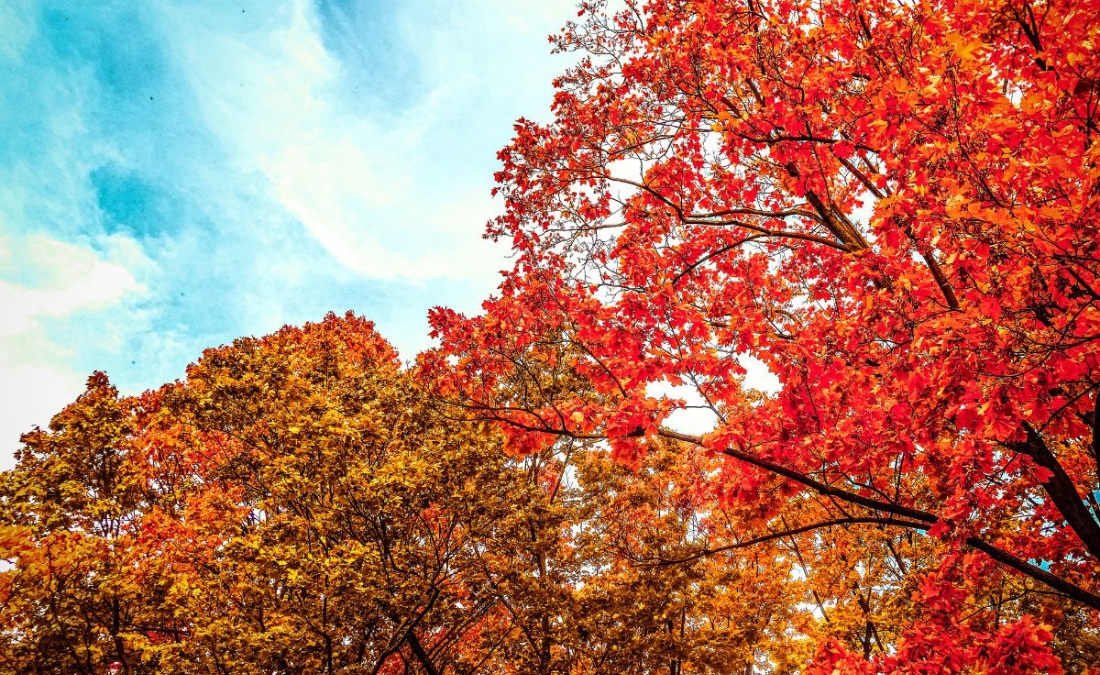
Why do some Central Midwest trees thrive through winter while others fail? The secret is fall mulching. Discover proven techniques from Certified Arborists.
Each fall, homeowners across Iowa, Missouri, Kansas, and Illinois spend hours raking leaves, cleaning gutters, and winterizing their homes. However, in the rush to prepare for colder weather, one critical task is often overlooked – fall mulching.
When applied at the right time with proper techniques, organic mulch creates a protective barrier that shields tree roots from freezing temperatures, pests, and soil erosion. More than just winter protection, mulching also improves soil health, reduces maintenance costs, and helps trees thrive with stronger growth when spring returns.
Key Takeaways
- Fall mulching provides superior winter protection compared to spring application by insulating roots during the Central Midwest’s freeze-thaw cycles.
- Proper 2–4-inch depth prevents “mulch volcano” damage commonly seen around mature trees in most neighborhoods.
- Organic mulch types are best suited for Central Midwest soil conditions, ranging from prairie soils to glacial till deposits.
- Strategic fall timing reduces spring maintenance costs by suppressing weeds and retaining soil moisture through winter dormancy.
Why is Fall the Best Time to Mulch Trees in the Central Midwest?
The timing of mulch application can make the difference between thriving trees and winter-damaged landscapes. In the unique Central Midwest climate zone (USDA Hardiness Zones 5a-6b), fall mulching provides three distinct advantages over spring application:
- Creates an Insulating Layer that Stabilizes Soil Temperatures: The Central Midwest is notorious for having particularly brutal freeze-thaw cycles. A properly applied 2–4-inch layer of organic mulch can drastically reduce soil temperature fluctuations, protecting the critical root zone where trees store energy for spring growth.
- Supports Soil Microorganisms: As the mulch slowly decomposes throughout the winter, it creates a nutrient-rich environment that feeds beneficial microorganisms found in the soil. By spring, these microorganisms have established thriving populations that immediately support new root growth and help trees recover from winter dormancy more quickly.
- Suppresses Early Spring Weeds: Weed seeds that would typically germinate with the first warm spell remain blocked by the mulch barrier, giving tree roots uncontested access to all the spring moisture and nutrients they need to support the tree in the upcoming growing season.
Which Organic Mulch Types Work Best for Central Midwest Trees?
Not all mulch is created equal, especially when dealing with the diverse soil conditions across Iowa, Missouri, Kansas, and Illinois. Check out the following organic materials that work synergistically with Central Midwest ecosystems:
- Wood Chips: Chips from hardwood trees are a solid mulch material for the Midwest’s conditions. These chips break down slowly, providing long-lasting benefits while supporting native soil biology.
- Shredded Bark: This material offers excellent water retention properties, which are particularly beneficial during dry winter periods. The fibrous texture allows air circulation while still maintaining consistent moisture levels around tree roots.
- Composted Leaves: Composted leaf mulch provides immediate nutrition but decomposes quickly, requiring more frequent applications. This works well for smaller ornamental trees but may not be cost-effective for large mature trees common in established neighborhoods. However, it’s also important to ensure the leaves used are healthy with no signs of disease.
PRO TIP: Avoid inorganic materials, like rubber mulch, rocks, or landscape fabric, which don’t provide soil nutrition and can create drainage problems in our region’s clay soils, glacial deposits, and prairie soils. Also avoid fresh wood chips from diseased trees or black walnut, which can inhibit other plant growth.

How Do You Properly Apply Mulch?
When it comes to mulch application, it’s important to be mindful of the depth and placement to avoid tree damage and ensure the mulch is adequately beneficial. Here’s what you need to know:
- Depth: Apply 2-4 inches of mulch. Thinner layers won’t suppress weeds effectively, while thicker applications can create anaerobic conditions that suffocate roots.
- Width: Extend mulch to the tree’s drip line when possible, or at minimum create a 3-foot radius circle around the trunk. Wider mulch rings provide greater benefits and protect trees from lawn mower damage.
- Trunk Clearance: Keep mulch 3-6 inches away from the tree trunk, creating a “donut” shape rather than a volcano. This prevents bark rot, discourages rodent nesting, and allows for proper air circulation.
Why You Should Avoid Mulch Volcanoes
Arguably, the most common mulching error we see throughout the Central Midwest is the dreaded “mulch volcano.” Piling mulch directly against the tree trunk traps moisture, encouraging fungal disease growth and providing pathways for insects that can girdle and kill even mature trees.
If you discover mulch volcanoes around your trees, it’s easy enough to correct. Simply pull the mulch back to create a 3–6-inch clearance around the trunk, redistribute the excess material to widen the mulch ring, and ensure the final depth remains 2-4 inches throughout the area.
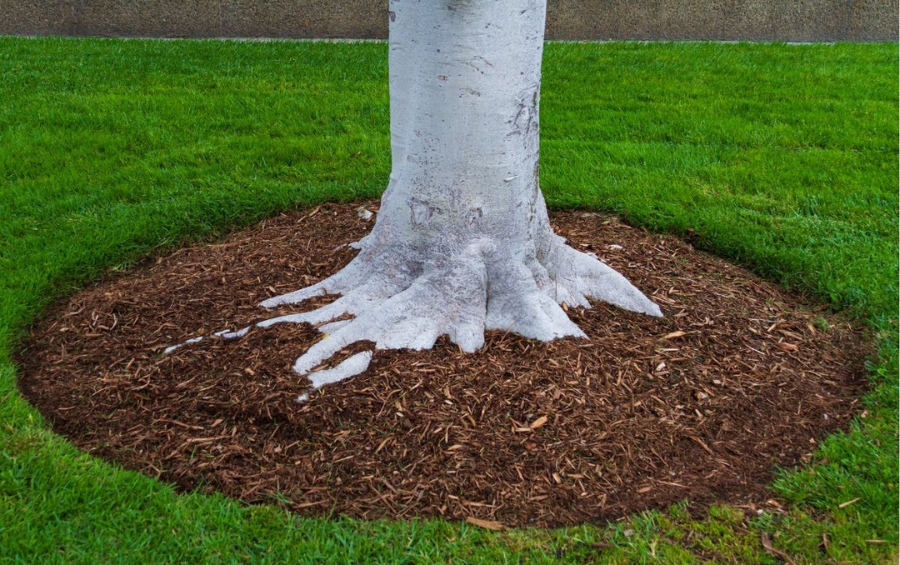
Proper mulch application creates a “donut” shape with clearance from the trunk to prevent damage.
How Central Midwest Soil Conditions Impact Fall Mulching
The diverse geological history of the Central Midwest directly impacts how homeowners should approach fall mulching, particularly for properties with mature trees that contribute to community character and property values.
The Central Midwest presents unique soil challenges that make fall mulching particularly important:
- Glacial Till Deposits: Found throughout much of Iowa, northern Missouri, and Illinois, these mixed clay, sand, and gravel soils from ancient glaciation can be compacted and challenging for tree roots.
- Prairie Soils (Mollisols): Rich, dark soils developed under native grasslands across the region provide excellent growing conditions but benefit from organic matter addition through mulching.
- Loess Deposits: Particularly prominent in western Iowa and parts of Missouri, these wind-blown soils can be highly productive but may face erosion challenges that mulching helps prevent.
- Clay-Heavy Soils: Common throughout much of the region, clay soils expand and contract with moisture changes, potentially damaging shallow tree roots without proper mulching protection.
Fall mulching helps address these soil challenges by moderating soil moisture fluctuations, improving soil structure over time, and rebuilding soil biology that naturally improves drainage and root health.
Understanding Mulching in the Context of Professional Tree Care
While mulching is a practice many property owners can handle on their own, understanding how it fits into comprehensive tree health requires knowledge of tree biology, local growing conditions, and specific property challenges. Professional arborists bring expertise that helps property owners make informed decisions about all aspects of tree care, including proper mulching practices.
When to Consult an Arborist About Your Trees and Mulching Practices
- Large Properties with Multiple Mature Trees: Properties with more than one tree (and especially when there is a variety of species) benefit from professional tree health assessments. Certified Arborists can evaluate individual tree needs and recommend appropriate care practices, including mulching techniques. Many established properties across the Central Midwest have 20+ mature trees that may require different approaches based on species, age, and site conditions.
- Properties with Drainage Issues: Common throughout the Central Midwest’s diverse soil types, drainage problems sometimes require professional assessment. An arborist can evaluate whether your current mulching practices are helping or potentially worsening water management issues and recommend adjustments.
- Historic or High-Value Trees: Properties in established neighborhoods across the region feature decades-old trees representing significant investments. If you’re unsure about the health of your mature oaks, maples, or other long-lived species, a professional tree inspection can identify problems before they become serious – including issues related to improper mulching that may not show immediate damage but weaken trees over time.
How Professional Tree Care Protects Your Investment
While you may handle mulching yourself, the practice works best as part of a comprehensive tree health program that includes services like regular inspections, proper pruning, and preventive treatments for common Central Midwest tree problems. These regular professional assessments and treatments prevent many common problems that require expensive interventions later, including:
- Root damage from temperature fluctuations, diseases, or pests
- Structural weaknesses that require cabling and bracing
- Pest infestations and diseases that stress trees
- Soil compaction and nutrient deficiencies that limit tree growth
Professional tree health care programs provide ongoing monitoring and treatments, ensuring mature trees remain healthy and valuable assets rather than suffering from slow, hidden decline.
Frequently Asked Questions About Fall Mulching in the Central Midwest
What is the best time to mulch trees in fall in Kansas City, MO?
The optimal timing for fall mulching in the Central Midwest is mid-October through early November, after leaves have fallen but before the ground freezes. This timing allows the mulch to settle and begin decomposing before winter while providing maximum insulation during the coldest months.
What are the signs you’re using the wrong type of mulch?
Warning signs include mulch materials that:
- Repel water instead of absorbing it
- Develops a sour or alcoholic smell
- Become slimy or moldy
- Contain visible pest activity
- Do not break down after two growing seasons
Additionally, if your trees show signs of stress like yellowing leaves or slow growth despite proper care, the mulch type may not be suitable for your soil conditions.
Does fall mulching prevent weeds better than spring mulching?
Yes, fall mulching is more effective at preventing weeds because it blocks weed seeds from germinating during the first warm spells of spring. The mulch barrier is established before weeds begin their growth cycle, giving trees uncontested access to spring moisture and nutrients that would otherwise be shared with competing weeds.
Should I remove old mulch before applying new mulch in the fall?
You typically don’t need to remove existing organic mulch if it’s breaking down properly and maintaining the correct depth. Simply rake the old mulch to break up any matted areas and add fresh material to restore the 2–4-inch depth. However, if the existing mulch is moldy, has developed a crust, or exceeds 4 inches total depth, removal or significant thinning is necessary.
How often should I refresh mulch around my trees?
Most organic mulches need refreshing annually. Fine materials, like shredded leaves, may need attention twice yearly, while coarser materials, like wood chips, typically last 12-18 months. The key is maintaining that consistent 2–4-inch depth and ensuring the mulch continues to provide weed suppression and moisture retention benefits.
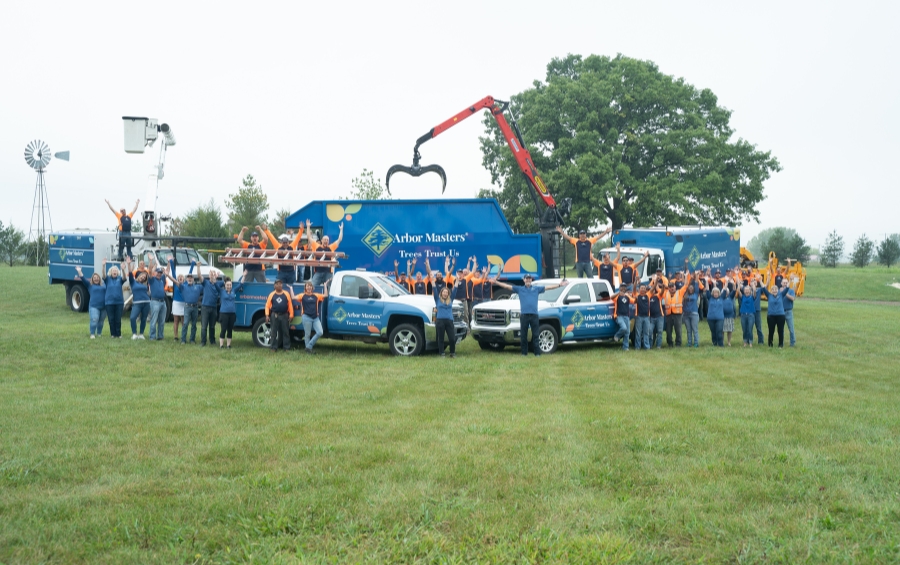
Protect Your Trees with Professional Tree Care from Arbor Masters
Don’t let another Central Midwest winter damage your valuable trees. Proper mulching is something many property owners can handle themselves using the techniques outlined in this guide. However, comprehensive tree health requires professional expertise. That’s where we come in.
With multiple Arbor Masters locations across Iowa, Missouri, Kansas, Illinois, and Texas, it’s easy to find expert care near you. Request an estimate online to connect with the branch closest to your property and learn more about how proper mulching supports professional tree care that keeps your trees healthy and thriving through winter and beyond.

Get the latest local news, tree care tips, special offers, and company updates directly to your inbox! It's easy to subscribe and there's no spam - we promise.
"*" indicates required fields



